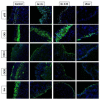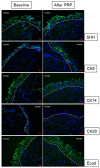Low-Energy Shock Wave Plus Intravesical Instillation of Botulinum Toxin A for Interstitial Cystitis/Bladder Pain Syndrome: Pathophysiology and Preliminary Result of a Novel Minimally Invasive Treatment
- PMID: 35203604
- PMCID: PMC8962423
- DOI: 10.3390/biomedicines10020396
Low-Energy Shock Wave Plus Intravesical Instillation of Botulinum Toxin A for Interstitial Cystitis/Bladder Pain Syndrome: Pathophysiology and Preliminary Result of a Novel Minimally Invasive Treatment
Abstract
Low-energy shock wave (LESW) therapy is known to facilitate tissue regeneration with analgesic and anti-inflammatory effects. LESW treatment has been demonstrated to be effective in treating chronic prostatitis and pelvic pain syndrome as well as overactive bladder, and it has a potential effect on interstitial cystitis/bladder pain syndrome (IC/BPS) in humans. LESW reduces pain behavior, downregulates nerve growth factor expression, and suppresses bladder overactivity by decreasing the expression of inflammatory proteins. Previous rat IC models have shown that LESW can increase urothelial permeability, facilitate intravesical delivery of botulinum toxin A (BoNT-A), and block acetic acid-induced hyperactive bladder, suggesting that LESW might be a potential therapeutic module for relieving bladder inflammatory conditions, such as bladder oversensitivity, IC/BPS, and overactive bladder. A recent clinical trial showed that LESW monotherapy was associated with a significant reduction in pain scores and IC symptoms. BoNT-A detrusor injection or liposome-encapsulated BoNT-A instillation could also inhibit inflammation and improve IC symptoms. However, BoNT-A injection requires anesthesia and certain complications might occur. Our preliminary study using LESW plus intravesical BoNT-A instillation every week demonstrated an improvement in global response assessment without any adverse events. Moreover, an immunohistochemistry study revealed the presence of cleaved SNAP25 protein in the suburothelium of IC bladder tissue, indicating that BoNT-A could penetrate across the urothelial barrier after application of LESW. These results provide evidence for the efficacy and safety of this novel IC/BPS treatment by LESW plus BoNT-A instillation, without anesthesia, and no bladder injection. This article reviews the current evidence on LESW and LESW plus intravesical therapeutic agents on bladder disorders and the pathophysiology and pharmacological mechanism of this novel, minimally invasive treatment model for IC/BPS.
Keywords: botulinum toxin A; interstitial cystitis; low-energy shock wave; urothelium.
Conflict of interest statement
The authors declare no conflict of interest.
Figures




Similar articles
-
Low energy shock wave-delivered intravesical botulinum neurotoxin-A potentiates antioxidant genes and inhibits proinflammatory cytokines in rat model of overactive bladder.Neurourol Urodyn. 2020 Nov;39(8):2447-2454. doi: 10.1002/nau.24511. Epub 2020 Sep 22. Neurourol Urodyn. 2020. PMID: 32960981
-
The clinical application of intravesical botulinum toxin A injection in patients with overactive bladder and interstitial cystitis.Tzu Chi Med J. 2022 Mar 11;35(1):31-37. doi: 10.4103/tcmj.tcmj_313_21. eCollection 2023 Jan-Mar. Tzu Chi Med J. 2022. PMID: 36866354 Free PMC article. Review.
-
Immunohistochemical evidence suggests repeated intravesical application of botulinum toxin A injections may improve treatment efficacy of interstitial cystitis/bladder pain syndrome.BJU Int. 2013 Apr;111(4):638-46. doi: 10.1111/j.1464-410X.2012.11466.x. Epub 2012 Sep 3. BJU Int. 2013. PMID: 22943596
-
Novel Applications of Non-Invasive Intravesical Botulinum Toxin a Delivery in the Treatment of Functional Bladder Disorders.Toxins (Basel). 2021 May 18;13(5):359. doi: 10.3390/toxins13050359. Toxins (Basel). 2021. PMID: 34069951 Free PMC article. Review.
-
Therapeutic Effect of Botulinum Toxin A on Sensory Bladder Disorders-From Bench to Bedside.Toxins (Basel). 2020 Mar 9;12(3):166. doi: 10.3390/toxins12030166. Toxins (Basel). 2020. PMID: 32182780 Free PMC article. Review.
Cited by
-
Pathophysiology and potential multimodal therapeutic strategies for IC/BPS.Nat Rev Urol. 2025 May 15. doi: 10.1038/s41585-025-01044-4. Online ahead of print. Nat Rev Urol. 2025. PMID: 40374927 Review.
-
A combined electrohydrodynamic atomization method for preparing nanofiber/microparticle hybrid medicines.Front Bioeng Biotechnol. 2023 Nov 15;11:1308004. doi: 10.3389/fbioe.2023.1308004. eCollection 2023. Front Bioeng Biotechnol. 2023. PMID: 38033817 Free PMC article.
-
Flavonoid Nobiletin Attenuates Cyclophosphamide-Induced Cystitis in Mice through Mechanisms That Involve Inhibition of IL-1β Induced Connexin 43 Upregulation and Gap Junction Communication in Urothelial Cells.Int J Mol Sci. 2022 May 1;23(9):5037. doi: 10.3390/ijms23095037. Int J Mol Sci. 2022. PMID: 35563427 Free PMC article.
-
Antinociceptive properties of intravesical/needle-free administration of abobotulinumtoxinA in a rodent model of chronic visceral pain: in vivo and histological evidence.J Neural Transm (Vienna). 2025 Mar 15. doi: 10.1007/s00702-025-02906-2. Online ahead of print. J Neural Transm (Vienna). 2025. PMID: 40089646
-
Intravesical Botulinum Toxin Injection Plus Hydrodistention Is More Effective in Patients with Bladder Pain-Predominant Interstitial Cystitis/Bladder Pain Syndrome.Toxins (Basel). 2024 Feb 1;16(2):74. doi: 10.3390/toxins16020074. Toxins (Basel). 2024. PMID: 38393152 Free PMC article.
References
-
- Apostolidis A., Jacques T.S., Freeman A., Kalsi V., Popat R., Gonzales G., Datta S.N., Ghazi-Noori S., Elneil S., Dasgupta P., et al. Histological changes in the urothelium and suburothelium of human overactive bladder following intradetrusor injections of botulinum neurotoxin type A for the treatment of neurogenic or idiopathic detrusor overactivity. Eur. Urol. 2008;53:1245–1253. doi: 10.1016/j.eururo.2008.02.037. - DOI - PubMed
Publication types
LinkOut - more resources
Full Text Sources

